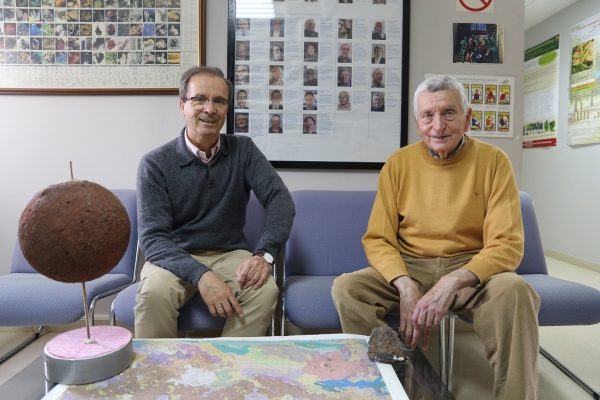Hematiteis a reddish iron oxide that owes its name precisely to its color, being called αίματίτηςλιθος ("bloodstone") by classical Greek authors. The formation of hematite is shaped by certain geochemical processes, such thatits color and magnetism properties can reveal what the conditions during its formation were like.
The study of the color and magnetism of hematite and itsrelationship with past climates, agronomic issues, and the information it can provide about Mars occupied part of the research by professors Vidal Barrón and José Torrent, with the Soil Science Unit of the María de Maeztu Unit of Excellence at the Department of Agronomy of the University of Cordoba (DAUCO). After more than 40 years of research on the properties of hematite, they wereinvited by the journal Reviews of Geophysics, together with researchers from universities in China, Australia and the Netherlands, to review the knowledge generated so far on the properties of this iron oxide, its current applications, and the role it could play in the study of the neighboring planet.
The article features research on the properties and methods to identify and quantify hematite and how this knowledge can be applied to explainthe characteristics of current and past environments and climates;and, ultimately, to learn more about climatic evolution.
Life on Mars? The potential of hematite on the red planet
NASA's Curiosity rover found spectral evidence of hematite near Mount Sharp in Mars' Gale Crater, and hematite is one of the most common minerals on the Martian surface. Thus, variations in the content, color and magnetism of hematite on Mars may provideclues about past climatic variations, the presence of water, and, perhaps, life. This is why the article also discusses research aimed at using hematite to obtain information about the neighboring planet.
Martian regions containing hematite are considered key to the search for potential life in the past. Considering that well-dated terrestrial hematite allows for detailed reconstructions of, for example, monsoons, the presence of hematite on Mars tends to be associated with the previous presence of water. Thus, the study raises the questions to be resolved to better understand the geology of Mars and the need to expand our knowledge of the relationship between terrestrial and Martian hematite.
Hematite at the field level: a resource in agronomic management
"From the agronomic point of view, the study of this iron oxide allows for the enhanced use of soils, facilitatingbetter fertilization management," explains Professor Torrent. "A Brazilian team we work with hasproduced soil fertility maps based on the color and magnetic properties of iron oxides," adds Barrón in relation to its agronomic applications, as hematite has a great impact on the behavior of phosphorus in soil, a key nutrient in crop fertilization, and one that it is not always easy to obtain.
After more than 30 papers in collaboration with the authors of the Chinese team involved since 2004, this new review lays the foundations for knowledge of hematite and makes it possible to continue deciphering the clues that this mineral offers about Earth and Mars, as shown in the recent article published in Nature, in which, using methods employed in magnetic studies of hematite to analyze archaeological finds, a better understanding of the evolution of Homo sapiens in Asia was achieved.
Reference
Jiang, Z., Liu, Q., Roberts, A. P., Dekkers, M. J., Barrón, V., Torrent, J., & Li, S. (2022). The magnetic and color reflectance properties of hematite: From Earth to Mars. Reviews of Geophysics, 60, e2020RG000698. https://doi.org/10.1029/2020RG000698.


